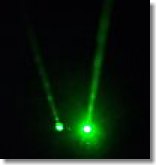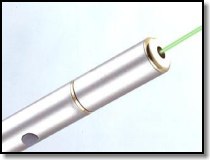
Lasers Aimed At Airliners
Overreaction?
 | Equipped To Survive Foundation Lasers Aimed At Airliners Overreaction? |
 Recently the media has been filled with reports of lasers aimed at airliners and dire warnings about their dangers and possible use by terrorists to blind pilots. While I don't doubt that some terrorist somewhere has contemplated using a laser in such manner, there's a far more likely and less sinister explanation. While most of us are familiar with red laser pointers, green laser pointers have also been available for some time, but the cost differential has been so great as to limit their use. It wasn't too long ago that a green laser pointer cost over $1000. Now, the cost has come down to less than $50 and high quality ones are available for less than $100. Since they offer all sorts of advantages over red lasers, with the price point lowered out of the stratosphere they are spreading like wildfire.
Recently the media has been filled with reports of lasers aimed at airliners and dire warnings about their dangers and possible use by terrorists to blind pilots. While I don't doubt that some terrorist somewhere has contemplated using a laser in such manner, there's a far more likely and less sinister explanation. While most of us are familiar with red laser pointers, green laser pointers have also been available for some time, but the cost differential has been so great as to limit their use. It wasn't too long ago that a green laser pointer cost over $1000. Now, the cost has come down to less than $50 and high quality ones are available for less than $100. Since they offer all sorts of advantages over red lasers, with the price point lowered out of the stratosphere they are spreading like wildfire.
Anyone notice that these reports have become so common only since the holidays? It doesn't take much of a leap of logic to figure this out. The unique capabilities of these green laser pointers just begs them to be aimed at aircraft, a natural nighttime target. Now the police are arresting people who innocently try out their new toy.
 Let's address one issue first--safety. All these consumer grade inexpensive laser pointers are Class IIIa laser devices with a maximum output power of less than 5mW (milliwatts). These devices are stringently regulated by the FDA and at this power level they are eye safe even at very close range. That means you can shine them at your eye momentarily at close range without any danger of permanent damage. The Feds have set the limit low enough that you would have to work at hurting yourself or others with these consumer grade lasers from any distance beyond very close in and at the distances from which an airline cockpit could be illuminated on approach, they are harmless.
Let's address one issue first--safety. All these consumer grade inexpensive laser pointers are Class IIIa laser devices with a maximum output power of less than 5mW (milliwatts). These devices are stringently regulated by the FDA and at this power level they are eye safe even at very close range. That means you can shine them at your eye momentarily at close range without any danger of permanent damage. The Feds have set the limit low enough that you would have to work at hurting yourself or others with these consumer grade lasers from any distance beyond very close in and at the distances from which an airline cockpit could be illuminated on approach, they are harmless.
The human eye is most sensitive to a wavelength of approximately 550 nm (blue-green). The closer to this wavelength the laser is, the brighter it will appear, and a green laser at about 532 nm is very near optimum. As a result, green lasers are approximately 50 -100 times more receptive to dark-adapted eyes according to authoritative sources. This translates to them being visible at far greater range for the same power output. Ranges of these devices easily go out tens of miles for someone viewing from the target. We have tested a prototype laser distress signaling devices of only 4 Mw that was readily visible out past 30 miles.
 A green laser is so much easier seen that when pointing it up into the night sky the smallest amount "dust" in the atmosphere, present virtually anywhere, reflects back visible light so that there is a visible green line. This makes it very easy to aim at a target. One of the early adopters of green laser pointers were astronomy instructors and enthusiasts who would use them to point out celestial objects.
A green laser is so much easier seen that when pointing it up into the night sky the smallest amount "dust" in the atmosphere, present virtually anywhere, reflects back visible light so that there is a visible green line. This makes it very easy to aim at a target. One of the early adopters of green laser pointers were astronomy instructors and enthusiasts who would use them to point out celestial objects.
When we tested that prototype green laser distress signaling device in ground to air mode we started in very close, only a few thousand feet away before flying out further. While clearly visible and highly noticeable, at no time were we blinded or otherwise adversely impacted by the laser light. While the general public has this image of a laser being a pinpoint beam that goes on forever at the same width as they see it exiting the pointer, the reality is that on typical Class IIIa lasers the beam divergence is large enough that at any significant distance (a few hundred yards or more) the laser appears to the viewer as a bright light, but not blinding or dazzling so as to impair vision.
More recently, the media has taken note of somewhat more powerful lasers, up in the area of 20 Mw, that can be obtained for less than $1000, which has again ignited fears. While these are more dangerous close up, they too lack the necessary power to do any damage at any significant distance unless a person were able to stare at the laser for an extended period of time. That is an improbable scenario, both because it is so difficult to maintain the laser on the moving cockpit of an airliner and because no pilot is going to sit and stare at the laser, even if it was able to be aimed that precisely.
As those who have done laser signaling evaluations with me will attest to, it is not easy to deliberately hit an airplane cockpit with a laser, even with a sighting system attached. It's also very difficult to keep the laser on target with something as small and fast-moving as an airplane cockpit, even close in. Even then, because of the difficulty of keeping the laser on target, the laser generally appears only as sporadic flashes of very brief duration, not as a steady bright beam.
Even were it possible to effectively aim a laser and somehow interfere with a pilot's vision for more than an momentary period of time, it is unlikely that an aircraft could be caused to crash as a result. First, airliners have two pilots and both pilots would have to be incapacitated. Both pilots would have to be stupid enough to stare at the laser, and I don't know any airline pilots that stupid, especially now that this subject has received all this publicity. Second, there have been numerous instances over the years of pilots being permanently incapacitated on final approach, having heart attacks and dying, without the aircraft crashing. That's what the second pilot is for. Moreover, with modern airliners, a missed approach (go around) is so automated that it is literally just a punch of a button away and the autopilot does it all.
There have been calls to make aiming a laser at an aircraft a specific federal offence (the overwrought, make an example at the expense of some stupid sod's life, current prosecutions use catch-all criminal statutes for prosecution). There are already laser distress signaling devices in wide use today by both civilian and military that utilize lasers to signal aircraft. Lasers represent one of the most effective nighttime distress signaling devices available to survivors. If the politicians really need to be seen as doing something about this non-problem, let the regulatory authorities, in this case the FDA, insure that an additional cautionary statement is added about not aiming lasers at aircraft or automobiles except in an emergency.
Yes, it is possible for someone to construct a laser powerful enough to potentially blind an airline pilot in flight, at least temporarily, and to equip it with a sophisticated enough aiming system to be effective as a weapon. It wouldn't be small, lightweight, easy to transport, or cheap. In fact, it would be pretty darn expensive. And, even then, the odds it would take down an aircraft are extremely small. I believe that the likelihood of any terrorist assembling such a "weapon" is extremely slim compared to elsewhere they might spend their limited resources, energy and funds. Use of lasers as effective weapons by terrorists is within the realm of possibility, but not the realm of probability.
Bottom line is that this appears to be much ado about not much. Airline pilots and passengers don't need to feel threatened if Johnny targets them with his shiny new green laser pointer. The feds can relax and spend their limited resources chasing some real bad guys.
Read a statement from the International Laser Display Association about "Lasers and Airplanes: Common Misperceptions" (opens a new browser window).
Press Release from Greatland Laser about their laser distress signaling devices (opens a new browser window).
Lasers Warn Pilots of Restricted Airspace as the U.S. Government turns to lasers directed at the cockpit to warn pilots (opens a new browser window).
Doug Ritter
|
Executive Director: Doug Ritter
© 2001 Equipped To Survive Foundation, Inc. - All rights reserved.
Check our Copyright
Information page for additional information.